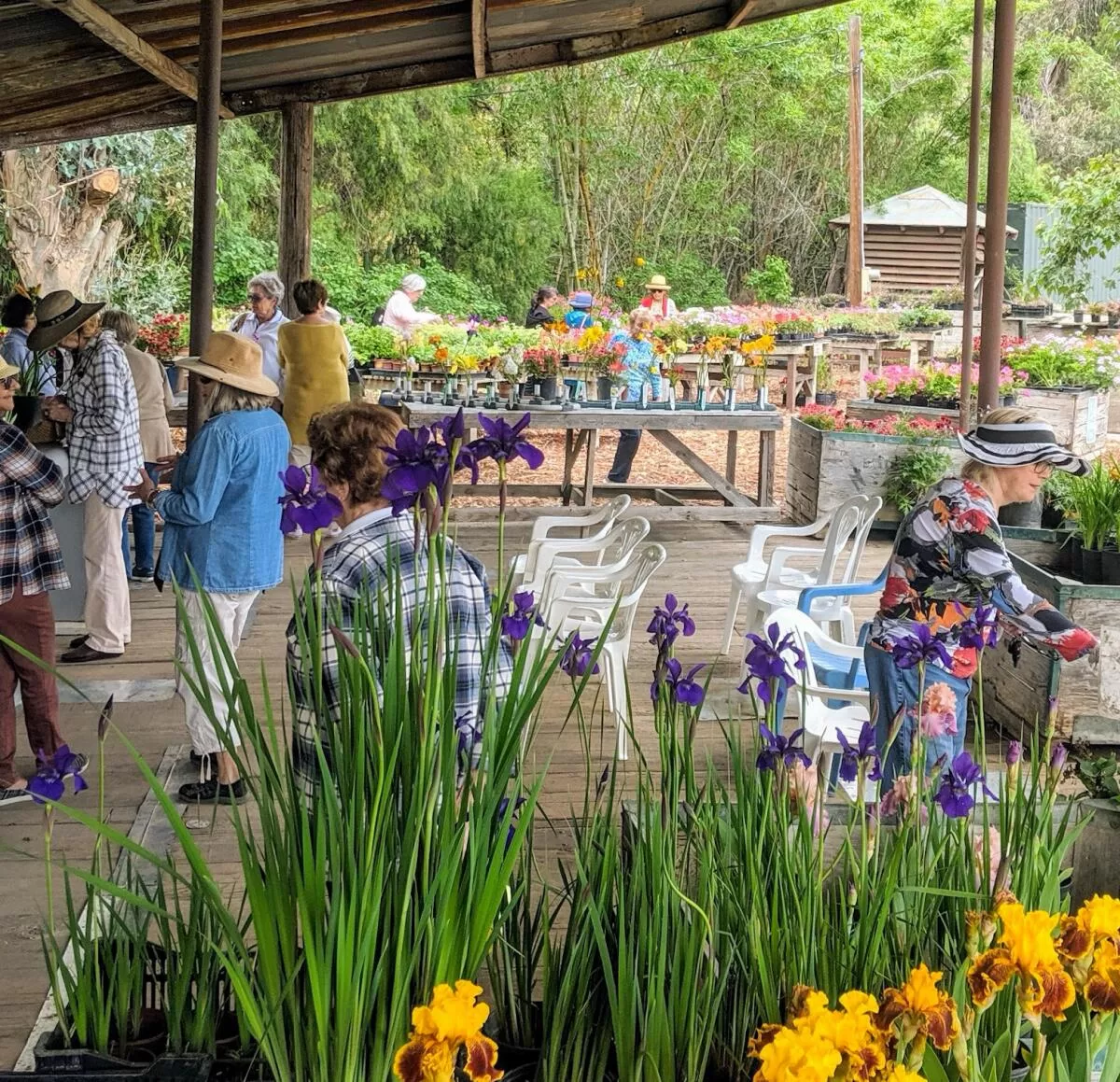I’m not going to end 2024 by muttering, “How can it be December?!” So let’s start like this: Happy holidays! Much love to you and yours! And thank goodness we’ve had some rain, so by the time you read this, the devastating Mountain fire that began Nov. 6 should finally be doused.
But the wreckage remains — some 243 structures destroyed, a quarter of Ventura County’s avocado groves blackened, power lines downed, miles of irrigation pipes melted … and a beloved perennial nursery in Somis burned and nearly shuttered.
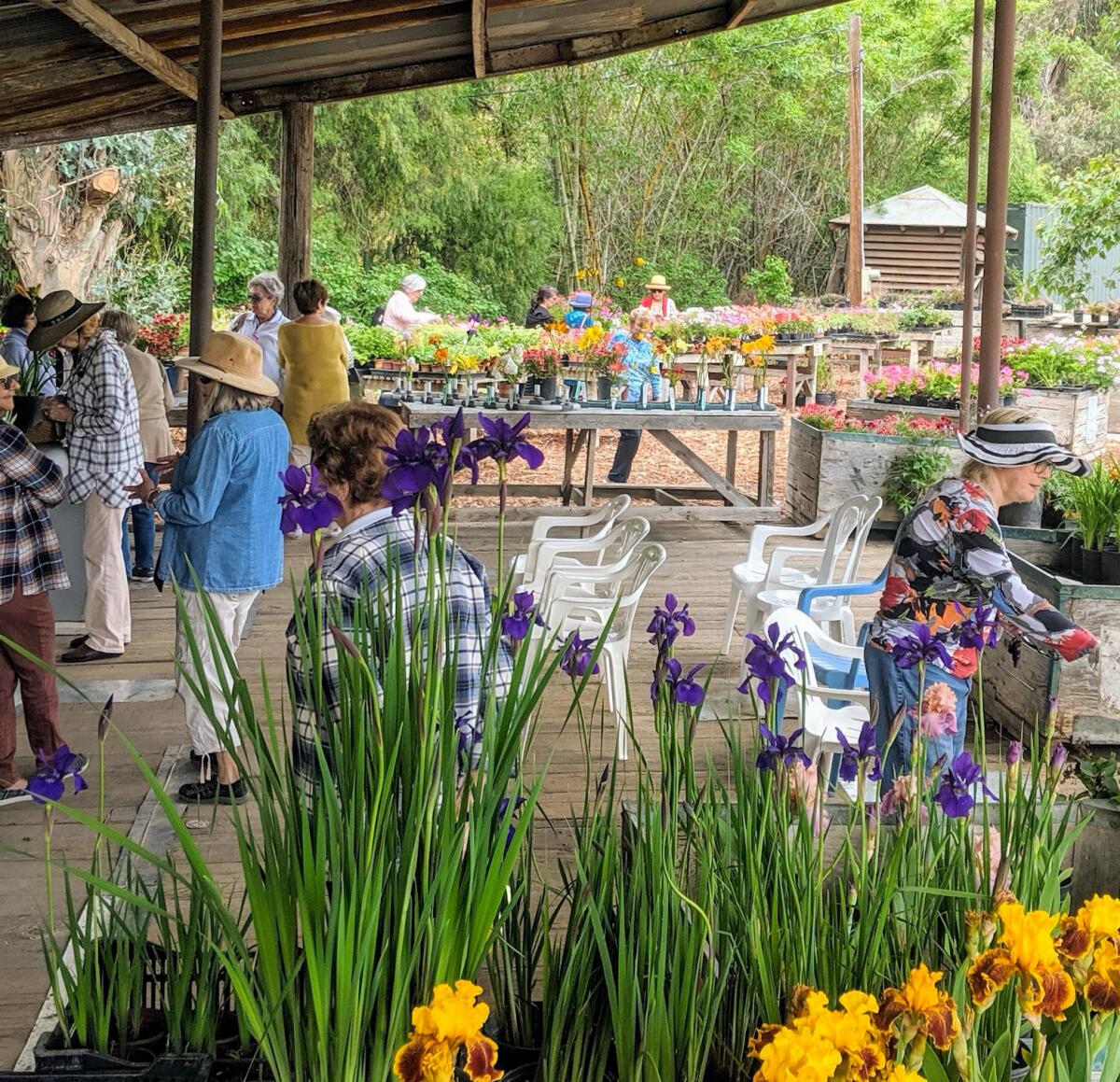
The Greenwood Daylily Nursery’s sheltered sales area last spring, before the Mountain fire, with its old wooden barn floor surrounded by blooming irises and other flowering perennials.
(John Schoustra)
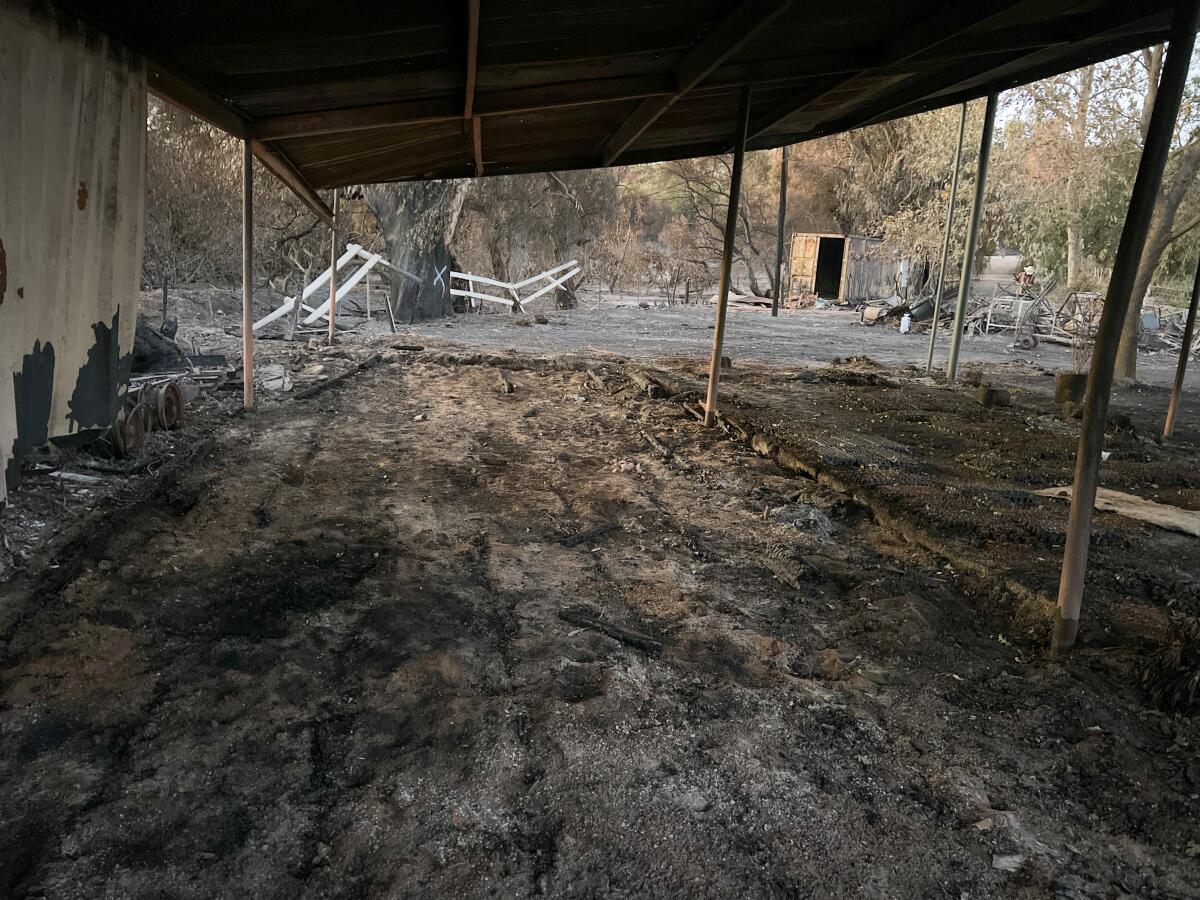
And the sooty remains of the sales area shelter in late November, after it was charred by the Mountain fire.
(Jeanette Marantos / Los Angeles Times)
Yet incredibly Greenwood Daylily Garden’s colorful irises survived, along with many other of its flowering perennials bred specifically to bloom and thrive in Southern California.
It’s hard to believe that plants like irises, with their frilly and frothy flowers, could be resilient enough to survive a moisture-sucking Santa Ana wind storm followed by a fire that blackened hundreds of mature avocado trees a few dozen feet away.
But the truth is, for all their delicate beauty, irises are super tough. One fall, while I was living in Central Washington, someone gave me a pile of iris rhizomes — the fleshy tubers that hold their roots. I put the pile under a tree with the best of intentions and then forgot it, only to discover the following spring that the rhizomes had rooted during the winter, under the snow, and were preparing to bloom.
You’ll find quite a list of plant-related activities in the calendar below, but first a few things I discovered about growing irises in Southern California, and why you should be growing some too:
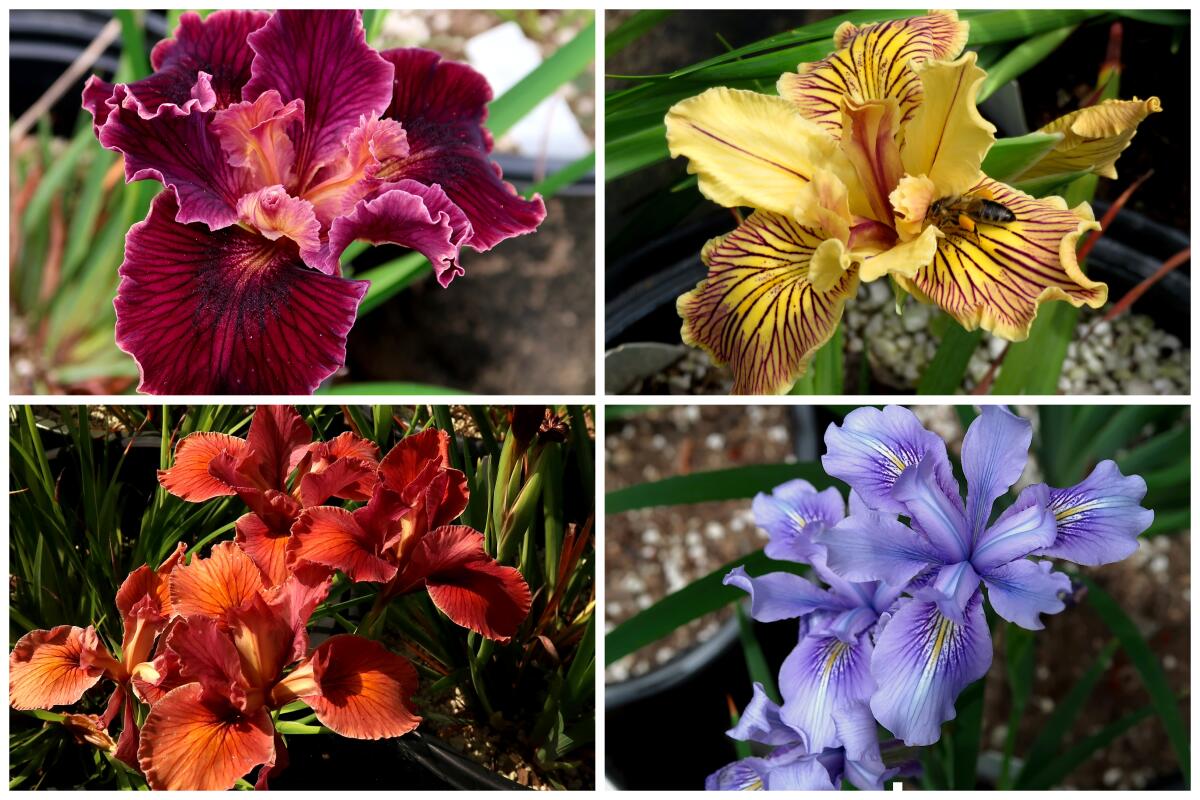
Four of the many deeply colored, shade-dwelling native Pacific Coast iris cultivated by Bob Sussman at Matilija Nursery, named (clockwise from upper left) Red Planet Iris, Golden Honeycomb Iris (bee not included), Matilija Blue Iris and Harry’s Rootbeer Iris.
(Bob Sussman)
- California and the Pacific Northwest have gorgeous native irises, known as Pacific Coast irises (see the selection from Matilija Nursery above) that are shorter than their tall bearded cousins but come in an eye-popping array of dramatic colors. They grow best in shade — such as under sprawling oaks or in small, well-drained planters on a townhouse patio. Keep them out of full sun and relatively dry, since they’ll rot if they get too much water.
- Non-native bearded iris are taller than their Pacific Coast cousins and prefer full sun. They come in a multitude of colors and last a week or longer as a vibrant cut flower because there are so many buds on a single stem. I’ve had a mahogany-colored stem known as Bernice’s Legacy in a vase for eight days now — Greenwood’s owner, John Schoustra a plucked it from his garden after the fire — and the last buds are finally beginning to fade.
- However, many bearded iris varieties need freezing winters to abundantly flower in the spring and fall, which is why SoCal gardeners can be disappointed unless they seek out low-chill varieties. (Schoustra has a helpful explainer on his website.)
- December is prime time for SoCal gardeners to plant these exotically beautiful, rugged flowers, which multiply over a couple of years so you can divide them, plant more or share with others.
Which led me to the most sobering bit of news:
- Two of the region’s premier iris growers, who specialize in irises designed for SoCal’s warmer climes, were right in the path of the Mountain fire.
Matilija Nursery, a Moorpark nursery owned by “Matilija Bob” Sussman, was surrounded by the fire, which somehow skirted around the edges of his property but left his plants unscathed. The nursery lost power, which meant Sussman couldn’t refill his water tanks. He had to truck in water to keep his wind-parched plants alive.
Sussman grows and sells many native plants but specializes in native Pacific Coast irises, which produce short dramatic blooms in the spring. You can admire photos of his beautiful irises online — as sumptious and sensuous as flowers painted by Georgia O’Keeffe — but you have to visit the nursery in person to buy.
Less than a mile to the west, Greenwood Daylily Gardens fared far worse. Although the fire missed owner Schoustra’s home at the top of his hilly property, it scalded nearly half of his 40-acre avocado orchard, destroyed most of his tools and nursery equipment and reduced his covered one-sided sales area and storage buildings to charred rubble.
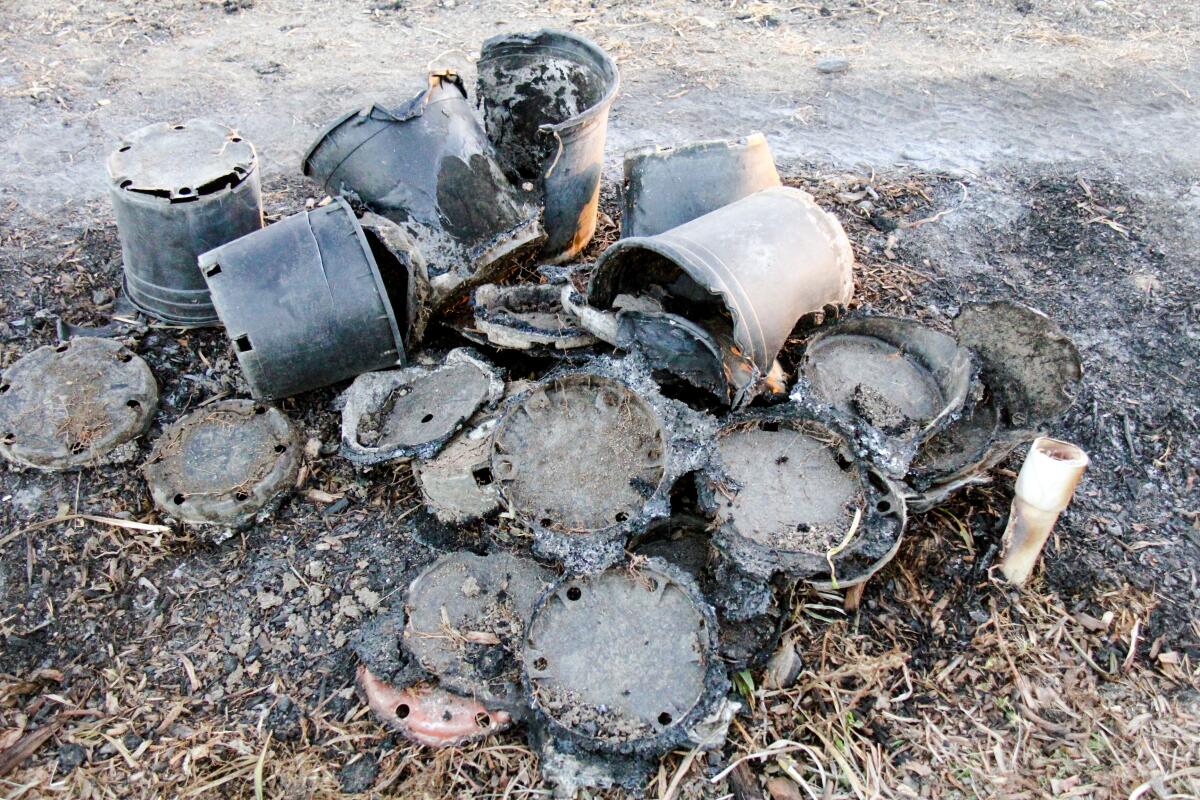
Heat from the Mountain Fire melted black plastic nursery pots right off the root balls of perennials at Greenwood Daylily Gardens.
(Jeanette Marantos / Los Angeles Times)
Schoustra’s wholesale nursery specializes in low-chill flowering perennials such as bearded irises, day lilies, geraniums and lilacs. As a longtime landscape designer and horticulturist, Schoustra said he got tired of purchasing plants developed for colder climates and watching them underperform for his SoCal clients, which in the case of irises meant lots of sword-shaped leaves but relatively few blooms.
So in 1989 he opened the nursery to cultivate low-chill varieties that thrived in our region. He continued his landscape design work for a while but now has a day job as orchard manager of Apricot Lane Farm in Moorpark (made famous by the award-winning documentary “The Biggest Little Farm”). He also sits on the board of the Southern California Horticultural Society as past president.
Evenings and weekends are devoted to his nursery, which is mostly wholesale except on Saturdays during April, May and June. That’s when he opens up the property to tour groups and gardeners who for years have come to bask in his nursery’s blooms and buy.
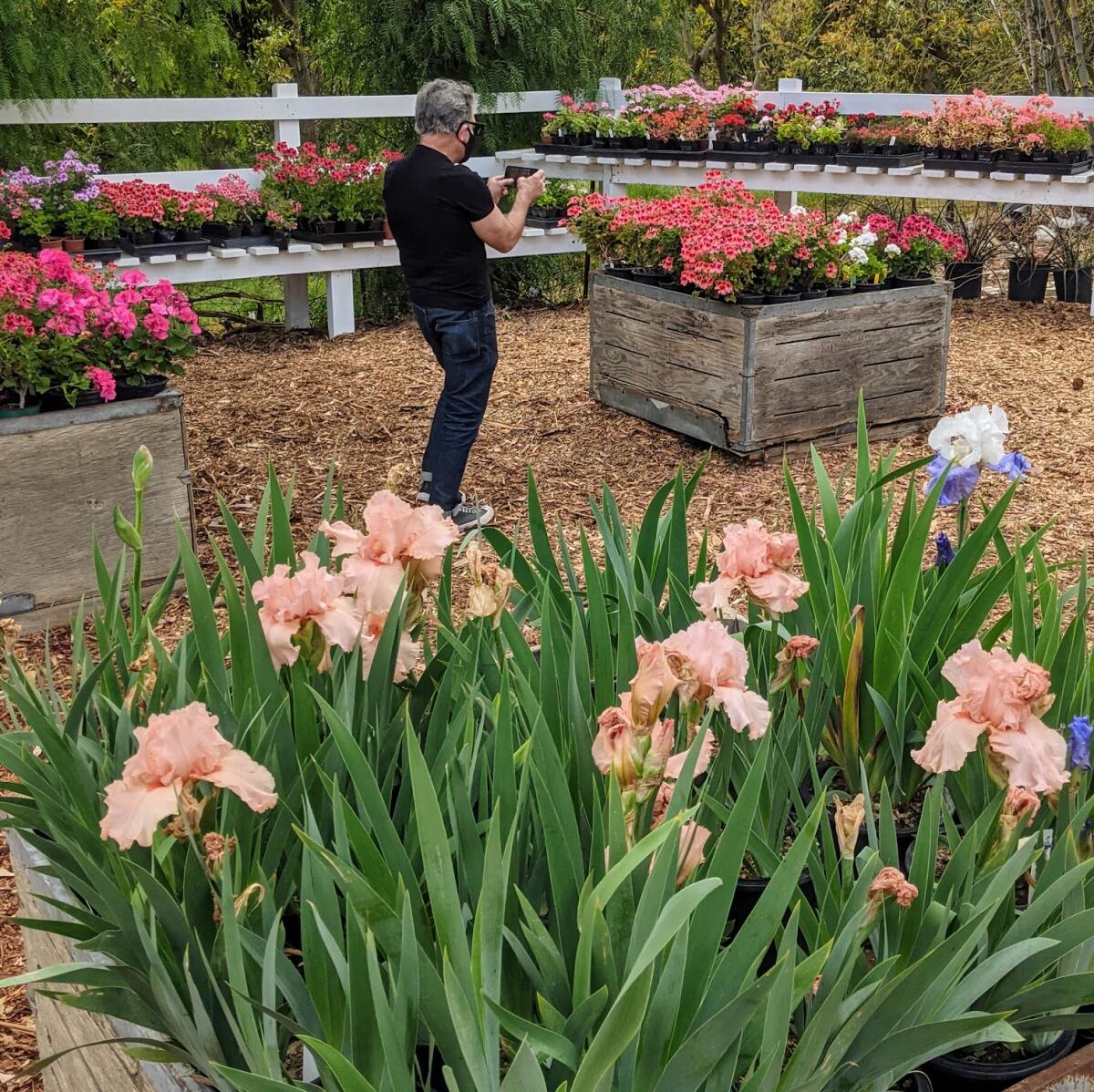
Peach-colored tall bearded iris known as ‘Peggy Sue’ bloomed profusely last spring at Greenwood Daylily Gardens. “They’re probably the best ‘landscape’ pink peach for Southern California,” owner John Schoustra wrote in a text, “more vigorous, with more reblooms and better year-round foliage than the popular ‘Beverly Sills.’” The garden’s ‘Peggy Sue’ iris were recently divided and repotted, so they won’t be available to purchase until April 2025, he said.
(John Schoustra)
It was hard to visualize all that lush growth a few days after the fire. Plastic pots had melted off the root balls of day lilies and irises. Hand tools like shovels were burned to nibs. Fences were twisted and blistered, rustic plywood fruit bins used for displays incinerated.
But somehow, Schoustra’s irises, daylilies and many other perennials survived. In fact, fresh green daylily shoots were poking out of the soil just days after the top leaves were charred.
The nursery does a brisk business in online sales, and that won’t change, Schoustra said. He has plenty of healthy plants to sell and was already preparing to ship out orders, just a week after the fire. He is eager for the income, because he figures that replacing his irrigation lines, avocado trees, tools and buildings will easily cost more than $100,000.
There were some plant losses, of course, beyond his avocado trees. When the fierce Santa Ana winds began before the fire, he’d moved trays of rare itoh peony seedlings to the nursery’s covered sales area to keep them from drying out. The partially enclosed rustic shelter had a handsome wood floor salvaged from an old barn, where nursery visitors could purchase plants or just rest out of the sun and admire the view.
“I thought they’d be safe here,” he said, but the shelter and its old barn floor became fuel for the fire. The plastic trays holding about $15,000 worth of peony starts were obliterated and the tiny balls of soil scalded in the heat. Some of the seedlings might survive, he said, “but we won’t know until the spring.”
However, Schoustra said he considers himself lucky. Nearby neighbors lost their homes. His home was saved, along with most of his nursery stock. And people have been incredibly kind.
Fellow horticulturists have dropped off hand tools and piles of black plastic pots to replace the ones he lost. Sean Henderson, manager of Aqua-flo’s Moorpark office, left him $5,000 worth of irrigation supplies while parts of the orchard were still smoldering, Schoustra said, and well before he had money to cover the cost, with instructions to pay when he could.
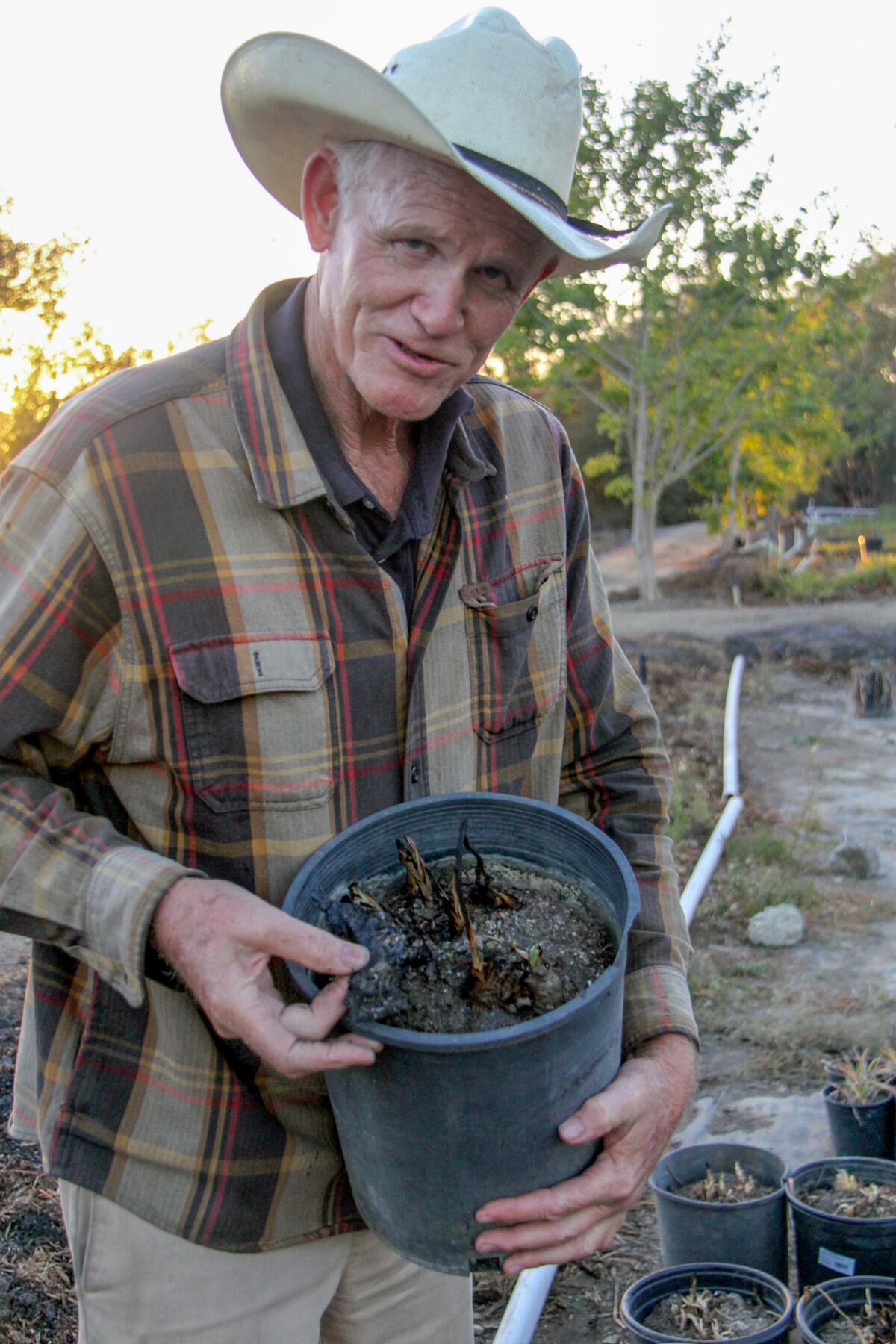
John Schoustra has found little sprigs of new growth in pots of burned daylilies. Overall, he said he feels pretty lucky.
(Jeanette Marantos / Los Angeles Times)
John Chester, his boss at Apricot Lane Farm, brought the farm’s water truck to the nursery during the fire to douse as big an area as he could, and then started a GoFundMe campaign to help Schoustra recover from his losses.
Schoustra admits that he’s bone weary right now, up before dawn, in bed around 8 p.m. and going nonstop in between, but he said all the support is inspiring.
“We’ll be ready to open again this spring,” he said confidently, poking around the ruins of his sales area. “It’ll just look a little different than before.”
After talking to Sussman and Schoustra, I realize that SoCal gardeners were lucky too. The fire could have consumed all those irises bred to flourish in our climate, so it’s kind of a holiday miracle that we still have the chance to add those flouncy pompadour flowers to our yards.
Check out Schoustra’s tall bearded options online, wait to shop in person this spring or, sometime this month take a drive to visit Sussman’s native plant nursery in Moorpark and buy yourself a gift of stunning spring color.
Newsletter
You’re reading the L.A. Times Plants newsletter
Jeanette Marantos gives you a roundup of upcoming plant-related activities and events in Southern California, along with our latest plant stories.
You may occasionally receive promotional content from the Los Angeles Times.
Upcoming events
Consider subscribing to the Los Angeles Times
Your support helps us deliver the news that matters most. Become a subscriber.
Dec. 6, 13, 20 and 27
Newport Bay Conservancy Sow & Grow Fridays, 9 a.m. to noon at the Back Bay Science Center in Newport Beach. Help grow native plants for restoration projects around Upper Newport Bay. Jobs include seed collection, sowing seed flats, transplanting seedlings, pruning, processing cuttings, composting, pot washing, weeding and maintaining the nursery space. Participants must be 13 or older, volunteers under 18 must be accompanied by a legal guardian. Tools and training are provided. Register online participation is free. eventbrite.com
Dec. 7, 14
Growing Works’ Succulent Wreath Workshop Fundraisers, 10 a.m and noon both days at the Growing Works Nursery in Camarillo. Tickets cover all materials needed to create a wreath, $55 for adults, $35 for children 12 and younger. interland3.donorperfect.net
Dec. 7, 14 and 21
Three-Part California Native Garden Design, a 12-hour course over three days taught by landscape designer and artist Mari Taylor of Deerbrush Design, 9:30 a.m. to 1:30 p.m. at the Theodore Payne Foundation in Sun Valley. Learn how to evaluate your existing garden, convert existing irrigation systems and create well-designed, sustainable spaces. This is not an introductory course; students must have already taken the foundation’s monthly online course, Right Plant, Right Place, (offered on Dec. 18) or be taking it in tandem with the garden design class. Register online, $348.65 (members $295.29) or $412.67 for couples working on the same project ($359.32 members). eventbrite.com
Dec. 7
Native Plants for School Gardens Workshop, a free workshop from 10-11 a.m. at the Tree of Life Nursery in San Juan Capistrano, discussing the experience of the Cerritos College Native Plant Sanctuary and how schools can use native plant education across academic disciplines, from science to the arts. Register online. californianativeplants.com
Beginners’ Deep Dive Into California Oaks, 1-4 p.m. at the California Botanic Garden in Claremont. Learn how to identify California native oaks, and what makes them such diverse and important habitat plants. About 45 minutes of the class will be spent walking through the garden to look at oaks; cart rides are available for those who need them. Register online, $35 ($25 for members). calbg.org
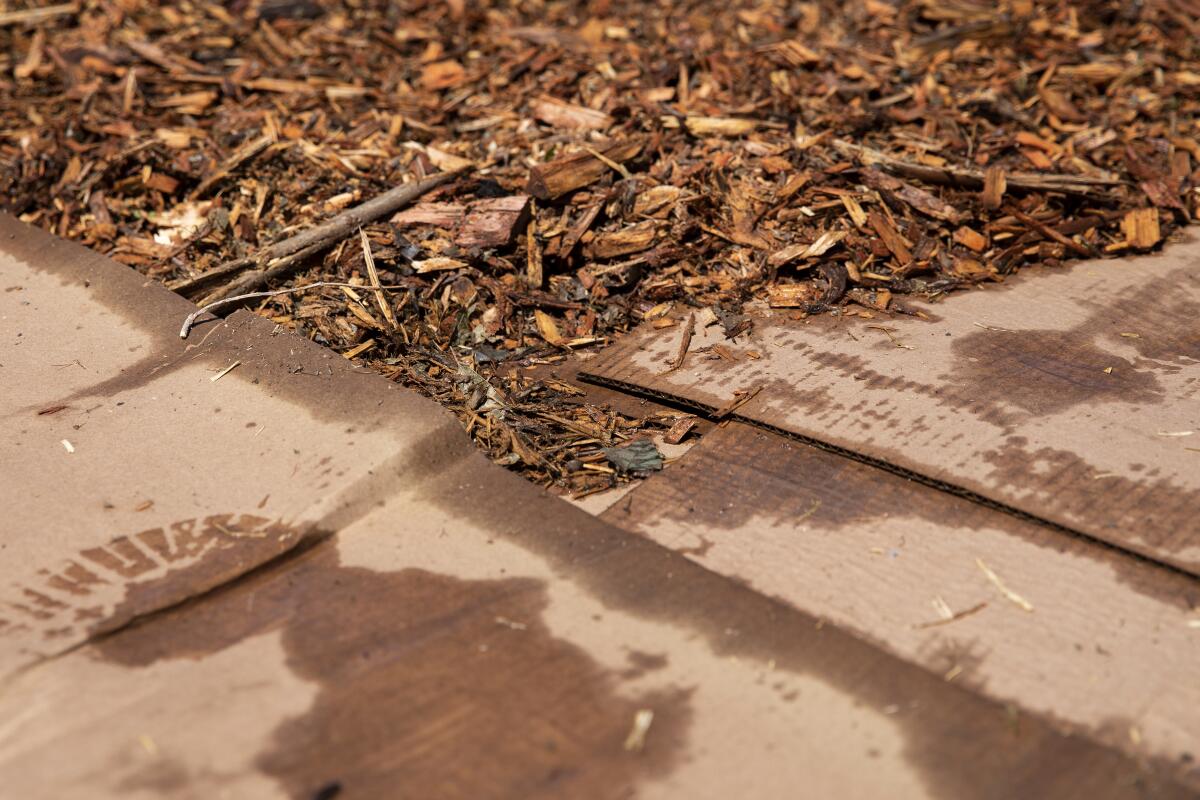
Wet layered cardboard covered with wood chips, a technique to kill weeds and build healthier soil known as lasagna mulching.
(Alisha Jucevic / For The Times)
Lasagna Mulching Workshop at the Crescent Farm at the L.A. County Arboretum, taught by the farm’s horticulturist John Latsko, 10 a.m. to noon at the farm. The class teaches how lasagna mulching — using flattened, wet cardboard and wood chips— helps improve soil health and suppress weeds. The workshop is free with $15 admission to the Arboretum ($11 seniors 62+ and students with ID; $5 children ages 5-12; children 4 and under and members enter free). Online registration is required. arboretum.org
DIY Wreath Making Party, 11 a.m-12:30 p.m. or 2-3:30 p.m. at the South Coast Botanic Garden in Rolling Hills Estates. Learn how to select and arrange botanical elements to create a handcrafted wreath. All materials provided. Register online for one session, $55 ($49.50 for members). 4664a.blackbaudhosting.com
Dec. 8
Hollywood American Legion Post 43 Volunteer Planting Day, 9 a.m. to 3 p.m. at the post’s historic building in the Hollywood Hills. Volunteers will help veterans finish the post’s turf replacement project by digging holes and planting new drought-tolerant plants purchased through the Los Angeles Department of Water and Power’s Turf Replacement Rebate. Post members also are offering free tours inside the building, a 1929 cultural monument, starting at noon. hollywoodpost43.org
Free Manzanita Mini-Workshop, 1-1:30 p.m. at the California Botanic Garden’s Grow Native Nursery in Claremont. Krista Von Stetten, a California native plant designer, explains how to choose and care for the manzanita tree, shrub or groundcover best suited for your space. Register online. calbg.org
Dec. 12
Capturing Nature’s Beauty: Smartphone Tips for Plant Lovers, a talk by art designer and photographer Marie Astrid Gonzalez during the Southern Califorrnia Horticultural Society’s monthly meeting and annual holiday potluck party, 7 to 9:30 p.m. at Friendship Auditorium in Griffith Park. Admission is free to members, $5 for non-members. socalhort.org
Native Plant Winter Maintenance Basics, a class taught by Erik Blank, horticulture educator at the Theodore Payne Foundation, who discusses seasonal maintenance practices and pruning techniques for native plants, 2 to 3:30 p.m. at the foundation nursery in Sun Valley. Register online, $18 ($15 members). eventbrite.com
Dec. 13
Wreath Making With California Native Plants, a hands-on workshop from 2 to 4:30 p.m. taught by Maryanne Pittman, the Theodore Payne Foundation’s director of public programs, at the foundation nursery. All materials are provided, including an 18-inch grapevine wreath and native plant cuttings, ribbons, floral wire and glue guns. One child, age 10 or older, is welcome to join a ticketed adult to make a wreath together. Register online, $71.21 ($60.54 for members). eventbrite.com
Intro to California Native Plant Garden Design, a workshop in basic landscape design using native plants taught by Theodore Payne Foundation Horticulture Director Tim Becker, 10 a.m. to 1 p.m. at the foundation in Sun Valley. Register online, $60.54 ($55.20 members). eventbrite.com

Gold-colored storm clouds blow over the Los Angeles Basin.
(Luis Sinco)
Dec. 14
Weather, Climate and California Native Plants, a class by earth scientist William Selby, author of “The California Sky Watcher,” 2 to 4:30 p.m. at the Theodore Payne Foundation in Sun Valley, explaining how to read clouds, understand weather patterns and read weather signs from plants. Register online, $39.19 ($33.85 for members). eventbrite.com
Dec. 15
Free California Lilac Mini-Workshop, 1-1:30 p.m. at the California Botanic Garden Grow Native Nursery in Claremont. Krista Von Stetten, a California native plant designer, explains how to chose and care for the best ceanothus (a.k.a. California lilac) tree, shrub or groundcover for your space. Register online. calbg.org
Dec. 20
Propagating California Native Plants From Cuttings, a hands-on workshop from 10 a.m. to 2 p.m. taught by Theodore Payne Foundation Horticulture Director Tim Becker, at the foundation nursery. Participants will learn how to start and grow plants from cuttings, and leave with a flat of 50 starts for their own garden. All materials provided. Register online, $92.55 ($81.88 for members). eventbrite.com
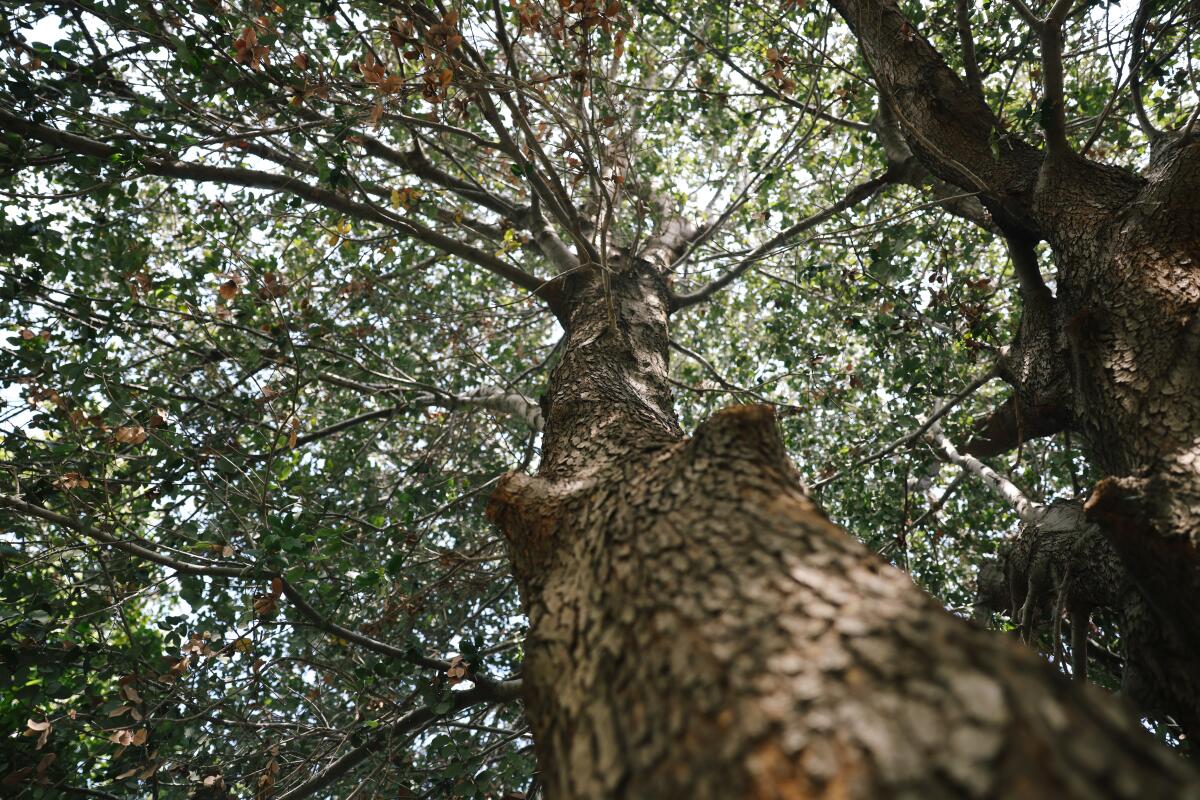
A towering island oak tree at Prisk Elementary School Native Plant Garden.
(Dania Maxwell / Los Angeles Times)
Dec. 21
Reading the Body Language of Trees, a one-mile walk-and-talk class led by arborist Alison Lancaster from 11 a.m. to 2 p.m. at the JPL Riparian Zone along the Arroyo Seco in Altadena. Lancaster will discuss why tree canopies move in the wind, how trees repair damage to their branches and other structural questions to help you assess a tree’s strength. Participants are encouraged to wear warm, festive attire since the class will be outdoors. Register online, $39.19 ($28.52 for members of the Theodore Payne Foundation). eventbrite.com
What we’re reading
So clearly I’m a flower fan, and my first trip to the Los Angeles Flower District was a dream come true. But with 70-plus vendors it’s easy to get overwhelmed. Check out my DIY guide for newbies.
Have a gardener on your gift list? Check out my personally curated gift guide for L.A. gardeners and plant parents.
Here’s a little motivation to start your own compost pile — or at least separate food waste from landfill waste (as required by California law), because Americans were expected to throw out 316 million pounds of food on Thanksgiving, and boy is that bad for climate change.
What happens when you keep pumping groundwater out of the ground? Ask the folks in San Joaquin Valley, where the land is sinking as much as one foot per year in some areas.
